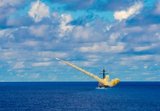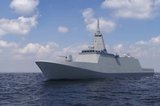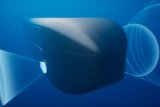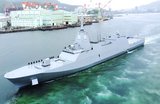Canadian frigate tests surface missiles
Canada's HMCS Vancouver, a Halifax-class frigate, has successfully tested Harpoon Block II surface-to-surface missiles against a shore-based target, it was announced on 8 April.
The launches were part of the the Joint Littoral Training Exercise (JoLTEX) that the Royal Canadian Navy completed at a US naval missile firing range off the California coast.
In addition to being the first time the navy has exercised such a surface-to-surface missile launch capability, the firings mark a milestone in reinstituting the navy's sea-to-shore missile capabilities, which will support Canadian forces' combat operations ashore.
The successful firing of the missile in CTS mode also marks the first time that Harpoon Block II missiles have been coupled with the modernised frigate's new combat management system for the purpose.
Commander Clive Butler, commander, HMCS Vancouver, said: 'From Vancouver’s perspective, JoLTEX 16 was a huge success. The missiles left the rails when ordered to do so, they followed the ordered path to the target, and they impacted the targets with precision. Vancouver’s team finished the exercise confident in the capability and excited to have contributed to the development of joint tactical doctrine.'
More from Naval Warfare
-
![NATO tests use of “undetectable, jam-proof” laser communication in maritime scenarios]()
NATO tests use of “undetectable, jam-proof” laser communication in maritime scenarios
As part of its effort to better prepare its capabilities for operations in contested and congested scenarios, NATO evaluated a Lithuanian ship-to-ship terminal designed to not be susceptible to enemy interference.
-
![US Navy advances with the Harpoon Service Life Extension Programme]()
US Navy advances with the Harpoon Service Life Extension Programme
The US Navy plans to improve Harpoon’s anti-ship and land attack capabilities by equipping the missiles with sensors and technologies required for succeeding in future battlespace.
-
![Mitsubishi eyes future with Australia’s Mogami selection]()
Mitsubishi eyes future with Australia’s Mogami selection
With Australia’s selection of the Mogami-class for Project Sea 3000, Mitsubishi is investigating local production in the next decade as potential export opportunities emerge.
-
![Thales’ new Sonar 76Nano could equip UK Royal Navy on anti-submarine warfare missions]()
Thales’ new Sonar 76Nano could equip UK Royal Navy on anti-submarine warfare missions
The new sonar is designed to equip uncrewed underwater vessels, with the potential to be used by the Royal Navy for its Atlantic Bastion and Atlantic Net missions.
-
![Hanwha wins Australian government approval to increase its stake in Austal]()
Hanwha wins Australian government approval to increase its stake in Austal
The contract would mean the two shipbuilders can collaborate strategically and enhance shipbuilding capabilities in Western Australia.























